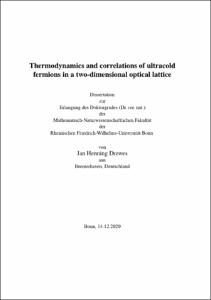Thermodynamics and correlations of ultracold fermions in a two-dimensional optical lattice

Thermodynamics and correlations of ultracold fermions in a two-dimensional optical lattice

| dc.contributor.advisor | Köhl, Michael | |
| dc.contributor.author | Drewes, Jan Henning | |
| dc.date.accessioned | 2022-05-20T14:37:18Z | |
| dc.date.available | 2022-05-20T14:37:18Z | |
| dc.date.issued | 20.05.2022 | |
| dc.identifier.uri | https://hdl.handle.net/20.500.11811/9814 | |
| dc.description.abstract | This thesis reports on experiments with ultracold fermionic 40K atoms in an optical lattice realising a quantum simulation of the two-dimensional Hubbard model. A central aspect of the experiments presented here is the combination of radio frequency spectroscopy techniques and a high resolution imaging setup. Thereby, both the in-situ density and spin distributions can be studied in a spatially resolved way.
In a first experiment, the in-situ density distribution has been investigated. Due to the high resolution of the imaging system, phases coexisting in the inhomogeneous trapping potential have been distinguished. Furthermore, the precise characterisation of the external confinement allows to determine the density equation of state, which fully characterises the thermodynamic properties of the many-body system in the investigated range of temperatures. As a hallmark of the repulsive Hubbard model, the crossover from a metal to a Mott-insulator has been observed. Furthermore, the precise determination of the equation of states allows us to apply the fluctuation dissipation theorem, in order to infer the suppression of non-local density fluctuations in the repulsive Hubbard model from the compressibility and the on-site occupation. Finally, a study of the spin degree of freedom is presented. This experiment relies on a novel spin sensitive detection technique, which has been developed during this thesis. Through a correlation analysis of the spatially resolved spin distribution, we have been investigating the influence of doping, interactions and temperature on the uniform spin structure factor. For strongly repulsive interactions and low temperatures, the data show the onset of antiferromagnetic correlations in the Mott-Insulator, which is a key step towards investigating the low temperature phase diagram of the two dimensional Hubbard model. | en |
| dc.description.abstract | In dieser Arbeit werden Experimente an ultrakalten 40K Fermigasen in optischen Gittern vorgestellt, mit denen eine analoge Quantensimulation des zweidimensionalen Hubbard-Modells realisiert wurde. Ein zentrales Merkmal der vorgestellten Experimente ist die Kombination von Radiofrequenz-Spektroskopiemethoden mit einem hochauflösenden Abbildungssystem. Diese Kombination ermöglicht die räumlich aufgelöste Untersuchung sowohl der Dichte- als auch der Spinverteilung.
In einem ersten Experiment wurde die Dichteverteilung untersucht. Durch die hohe Auflösung des Abbildungssystems können unterschiedliche in der Falle koexistierende Phasen unterschieden werden. Darüber hinaus erlaubt die genaue Charakterisierung des einschließenden Potentials die Bestimmung der Zustandsgleichung, die die thermodynamischen Eigenschaften des Vielteilchensystems im untersuchten Temperaturbereich vollständig beschreibt. Dabei wurde mit dem Übergang von einem Metall zu einem Mott-Isolator eines der Schlüsselmerkmale des repulsiven Hubbard Modells nachgewiesen. Aufbauend auf der präzisen Bestimmung der Zustandsgleichung wurde in einem weiteren Experiment das Fluktuations-Dissipations Theorems angewandt, um die Unterdrückung von nichtlokalen Dichtefluktuationen im repulsiven Hubbard-Modell abzuleiten. Abschließend wird eine Untersuchung des Spinfreiheitsgrades vorgestellt. Dieses Experiment beruht auf einer während dieser Arbeit entwickelten spin-sensitiven Detektionsmethode. Mittels einer Korrelationsanalyse der räumlich aufgelösten Spinverteilung wurde der Einfluss von Doping, Wechselwirkung und Temperatur auf den Spinstrukturfaktor untersucht. Für starke repulsive Wechselwirkungen und tiefe Temperaturen zeigen die Messungen die Präsenz von antiferromagnetischen Korrelationen im Mott Isolator und stellen damit einen wichtigen Schritt für zukünftige experimentelle Untersuchungen des Hubbard-Modells bei tiefen Temperaturen dar. | en |
| dc.language.iso | eng | |
| dc.rights | In Copyright | |
| dc.rights.uri | http://rightsstatements.org/vocab/InC/1.0/ | |
| dc.subject | Fermigase Gase | |
| dc.subject | Optische Gitter | |
| dc.subject | Hubbard Modell | |
| dc.subject | Antiferromagnetismus | |
| dc.subject | Fermi gases | |
| dc.subject | optical lattices | |
| dc.subject | Hubbard model | |
| dc.subject | antiferromagnetism | |
| dc.subject.ddc | 530 Physik | |
| dc.title | Thermodynamics and correlations of ultracold fermions in a two-dimensional optical lattice | |
| dc.type | Dissertation oder Habilitation | |
| dc.publisher.name | Universitäts- und Landesbibliothek Bonn | |
| dc.publisher.location | Bonn | |
| dc.rights.accessRights | openAccess | |
| dc.identifier.urn | https://nbn-resolving.org/urn:nbn:de:hbz:5-66567 | |
| dc.relation.doi | https://doi.org/10.1103/PhysRevLett.117.135301 | |
| dc.relation.doi | https://doi.org/10.1103/PhysRevLett.116.175301 | |
| dc.relation.doi | https://doi.org/10.1103/PhysRevX.7.031025 | |
| dc.relation.doi | https://doi.org/10.1103/PhysRevA.97.051602 | |
| ulbbn.pubtype | Erstveröffentlichung | |
| ulbbnediss.affiliation.name | Rheinische Friedrich-Wilhelms-Universität Bonn | |
| ulbbnediss.affiliation.location | Bonn | |
| ulbbnediss.thesis.level | Dissertation | |
| ulbbnediss.dissID | 6656 | |
| ulbbnediss.date.accepted | 20.07.2021 | |
| ulbbnediss.institute | Mathematisch-Naturwissenschaftliche Fakultät : Fachgruppe Physik/Astronomie / Physikalisches Institut (PI) | |
| ulbbnediss.fakultaet | Mathematisch-Naturwissenschaftliche Fakultät | |
| dc.contributor.coReferee | Weitz, Martin | |
| ulbbnediss.contributor.gnd | 1268246352 |
Files in this item
This item appears in the following Collection(s)
-
E-Dissertationen (4379)




